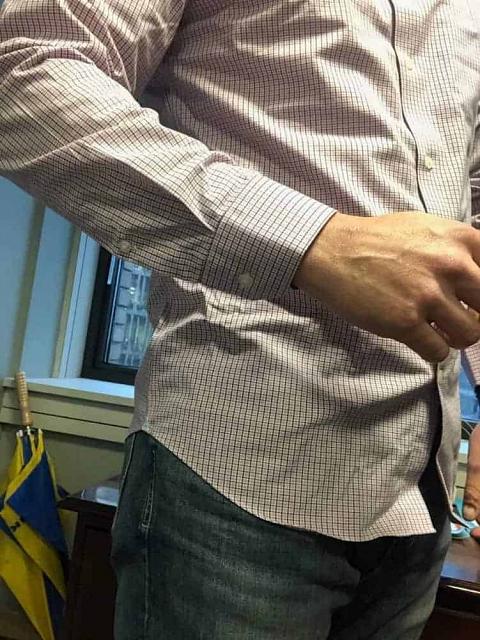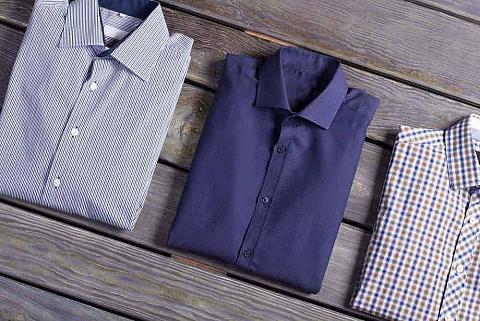They come in several styles, from long johns to tank tops. They work behind the scenes to keep you cool in the summer and warm in the winter. Learn about the different types and uses for men's undershirts, and and how you can rock them with class and style.
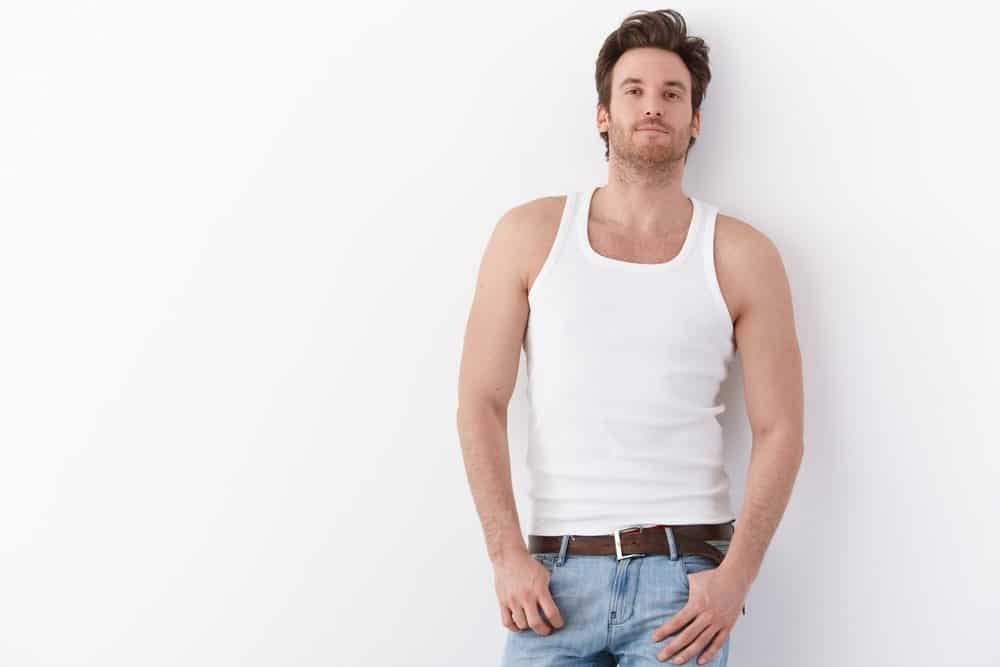
Think of it as underwear for the upper body. Most guys wear it in some form, in hot and cold weather alike. Others skip it altogether. Sometimes it’s worn as outerwear in a laid-back setting like relaxing at home.
Male celebrities have been filmed in it on the big screen. (Think Robert Downey Jr. in the Iron Man movies). This versatile, ubiquitous article of clothing is better known as a men’s undershirt, and it comes in several styles. Here’s your ultimate guide to the modern man’s undershirt.
Contents
- Types of Undershirts
- What Material Is Best for Undershirts?
- How It All Began: Unraveling the History of the Men’s Undershirt
- What Are the Advantages of Wearing an Undershirt?
- Should You Wear an Undershirt Under a T-Shirt?
- So What’s the Difference Between an Undershirt and a T-shirt, Anyway?
- How To Remove Deodorant Stains from an Undershirt
- How to Prevent Yellow Perspiration Stains
- FAQs
- What is undershirt pilling and what can be done about it?
- How do you choose the right kind of undershirt?
- Can you wear an undershirt under a polo shirt?
- Can you get away with wearing T-shirts and undershirts interchangeably?
- Can you wear an undershirt with a linen dress shirt?
- What are some things to keep in mind about dressy attire?
Types of Undershirts
You’d probably rather not go to the store and browse through all the undershirt options, so we’ll break them down for you.
White Cotton Tank Tops
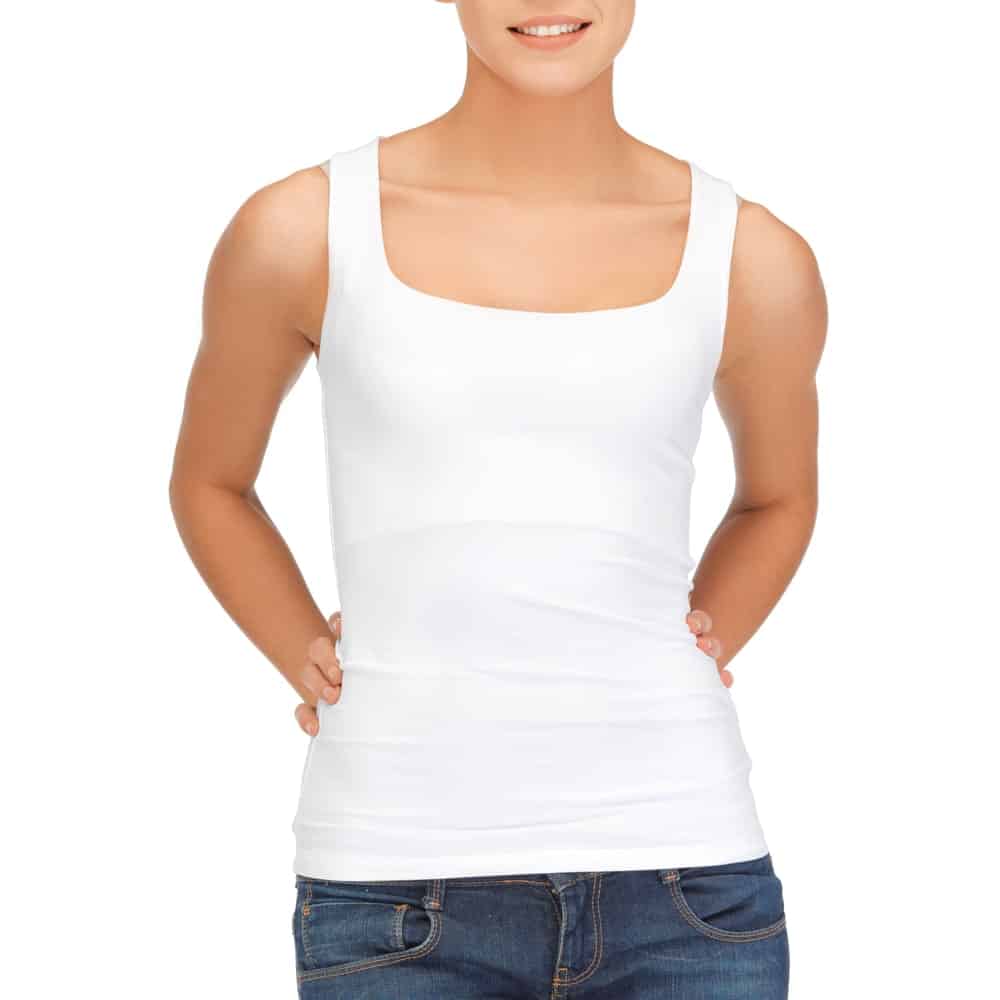
In the world of upper body underwear, a sleeveless undershirt is about as uncomplicated as you can get. Plain with a scoop neck, these are not meant to be displayed when you’re in public. Their simplicity makes them pretty low-cost, too. When you wear a plain cotton undershirt under a button-down shirt, be sure to button it to the point where you can’t see the neck of the undershirt.
The simplistic style of cotton tank tops means their use is limited to the above description. These garments are mass-produced to fit as many male body types as possible. As a consequence, they have huge armholes. So they won’t absorb much armpit sweat. Bottom line: White cotton tank tops are great for guys who don’t perspire much or who prefer to wear a short-sleeved or sleeveless shirt with a low neck.
V Neck Undershirt
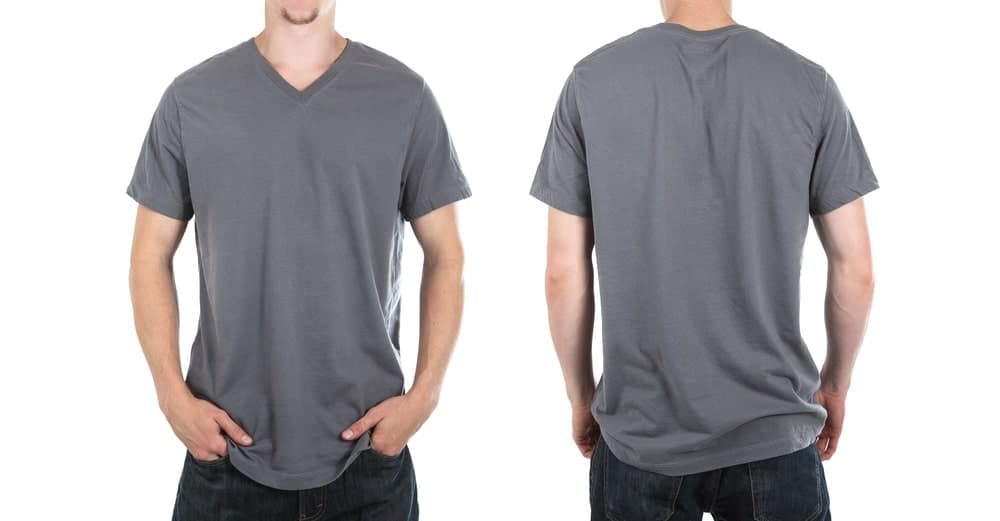
If you’d rather leave the first few top buttons on your collared shirt undone, then you can wear a V-neck shirt underneath. Some V necks are deeper than others, but in most cases, you can leave the collar button and at least one more button open without advertising your upper body undies to the world.
Otherwise, these under tees give you all the benefits of other types of T-shirts. But they should be worn as undershirts only and therefore shouldn’t be readily visible in public, especially when they’re white or gray. If you really want some of the undershirt to be visible, wear a brightly-colored one with another shirt over it.
Long-Sleeved Undershirts
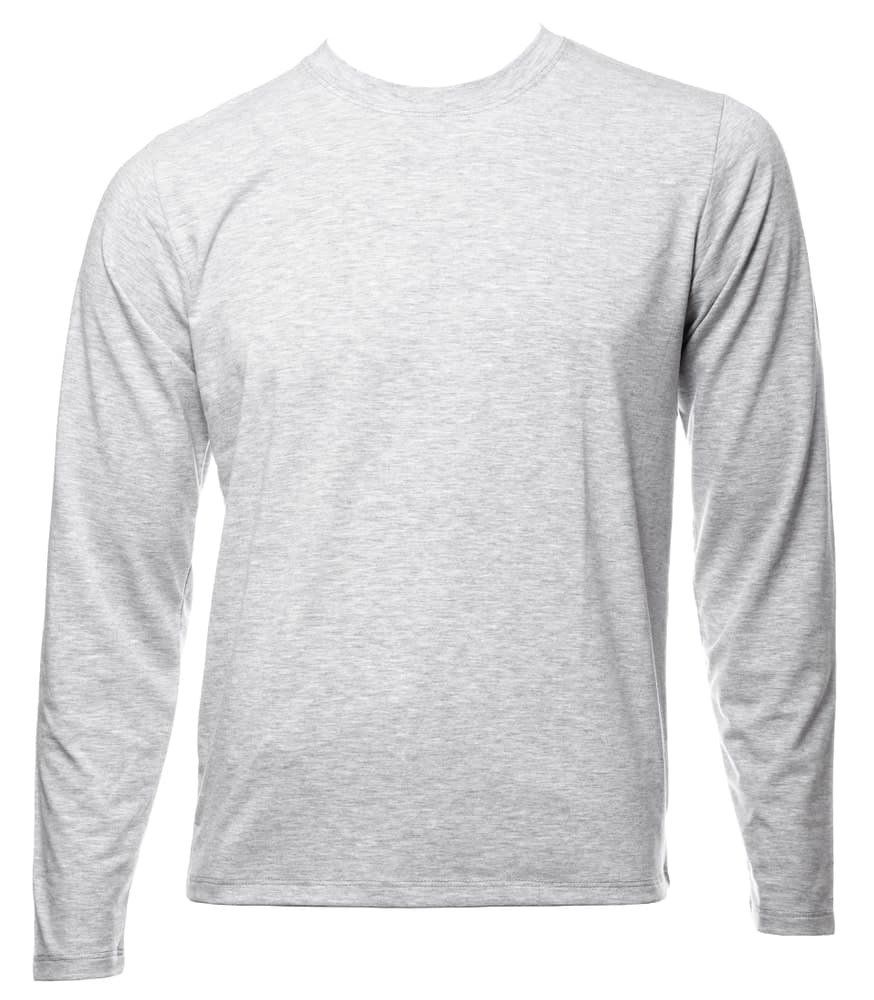
The long sleeve on this style makes it a close cousin to the long john underclothing that made its way onto the men’s clothing scene in the late nineteenth century. These give you all the advantages of other types of undershirts, with some extra insulation against cold weather.
Many long-sleeved tees come with a few buttons so you can open up the shirt collar if you’re feeling a little stifled. These are extremely casual, so you may be a little underdressed if you wear these sans an outer shirt.
Some guys do wear these as stand-alone. But wearing them with a layered shirt definitely looks classier. You can find long-sleeved undershirts in a wide assortment of colors. Where to buy them? These are most commonly carried by retailers like Old Navy and Gap.
Athletic Undershirt

As you might expect, these undershirts are designed for running at the track or pumping iron at the gym. Athletic shirts come in short sleeve and long sleeve varieties. They have moisture-wicking capabilities to keep you as cool and dry as possible while you burn carbs. As such, they make you a walking advertisement for whatever brand you prefer.
Workout under-gear usually comes in bright colors with athletic label-themed logos on it. That means these workout shirts typically aren’t the best choice to wear underneath dressier clothing. If you opt to go this route, wear a V neck so the neck of your undershirt is not visible. Plus, you’ll want to make sure those logos don’t show through your dress shirt.
Crew Neck Undershirt
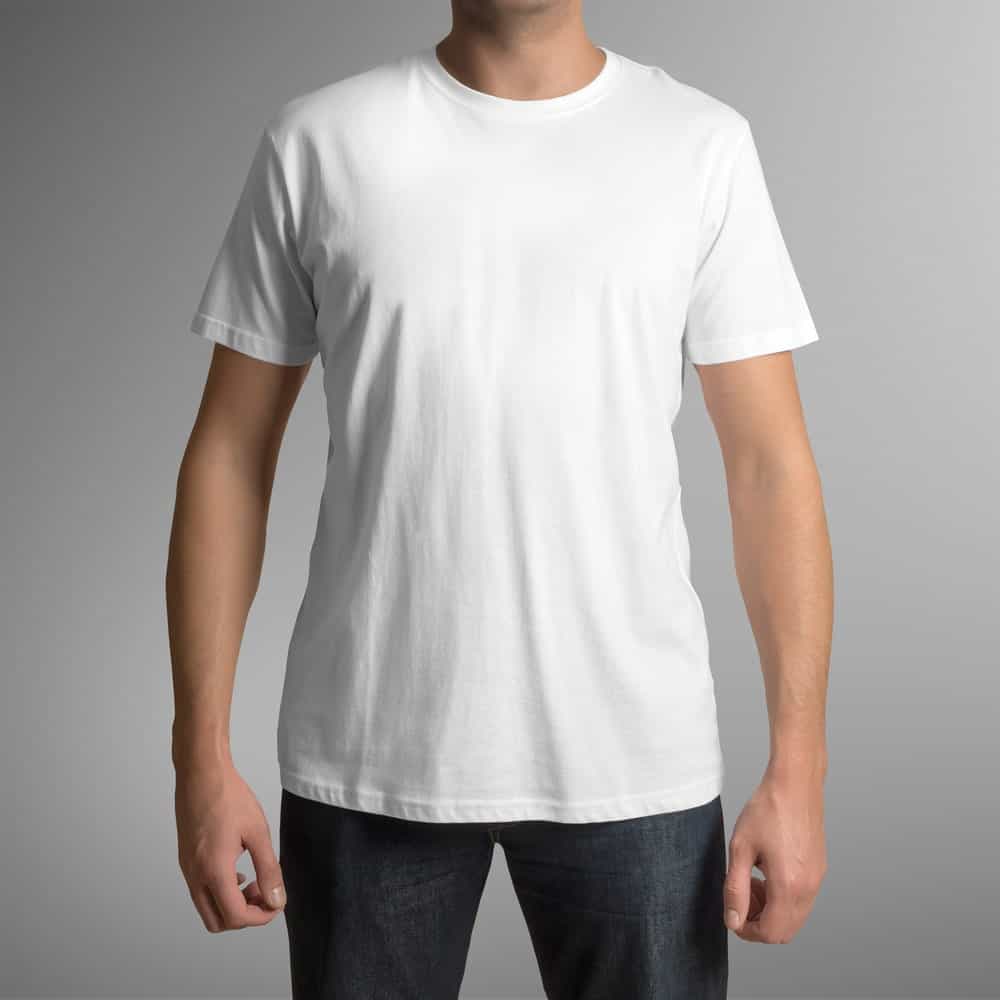
Crewneck undershirts should only be worn as undershirts. You can probably get away with sporting one as a crew neck t-shirt if you’re in good shape and your shirt fits well and is free of perspiration stains. This is not the classiest look, so use your judgment. When it’s fitted close to the chest and underarms, it gives you good sweat protection.
One disadvantage, though, is the high crew neck. When wearing it as an undershirt, you’ll need to button your outer shirt all the way up, so you can’t see the neckline of your inner shirt. In some cases, with dress shirts at least, you may need to have a button-up collar and necktie.
What Material Is Best for Undershirts?
Not sure which is the right undershirt for you? What’s important is how the garment feels against your skin. After all, you might be wearing it to prevent a scratchy garment from chafing your skin. So, here are some basic principles to consider.
- Look for fabric that is stretchy, soft, and thin.
- If you want a shirt that will hold its shape better, you can opt for cotton that’s blended with a synthetic like rayon. This combination will help your shirt keep its stretchiness, too.
- If you want undershirts that are 100% cotton, get high-quality material, like Pima cotton or Egyptian cotton. If you’ve ever had Egyptian cotton sheets, you know how luxurious they feel compared to regular cotton. Now, imagine having that grade of softness in a cotton shirt.
- If moisture-wicking properties are a priority, your best bet is probably a more modern material., such as TENCEL.
How It All Began: Unraveling the History of the Men’s Undershirt

The modern undershirt has come a long way since its humble beginnings thousands of years ago. The first record of guys wearing any kind of underclothing goes back to ancient times. Romans wore it for extra warmth or to protect their outer garments.
Soldiers wore it under their armor. Of course, these thin tunics looked nothing like today’s undershirts. But they did have one thing in common with our contemporary (under) clothing: They were designed mostly to soak up sweat.
Throughout the centuries, most efforts to manufacture and market underwear were geared toward women. But guys finally started to get some attention in this department in the late 1800s and early 1900s, when efforts to improve mass production were targeted toward the clothing industry.
This “clothing reform” movement applied scientific and manufacturing principles to make clothing more comfortable and less expensive. For men, this gave way to what came to be known as “union suits.” These one-piece long johns with posterior flaps soon became the butt of many a bathroom joke (no pun intended).
As awkward as these “union suits” look to us now, they ultimately served their purpose: protecting outer clothing from wear and tear, dirt, and sweat stains. Even better, they could be worn until they literally fell apart because no one was going to see them anyway.
Fortunately for men of the day, the early 1900s saw that cumbersome underwear fall out of fashion. US military members started wearing plain T-shirts issued by the Navy to protect their uniforms. The idea caught on among dockworkers and other laborers, too.
If you’d much rather wear an undershirt than one of those long john suits, you can thank World War II veterans. They popularized the practice of casually sporting their uniform pants and undershirts long after their service had ended. It’s from this laid-back upper body garb that the modern men’s undershirt and modern T-shirt evolved to what they are today.
What Are the Advantages of Wearing an Undershirt?
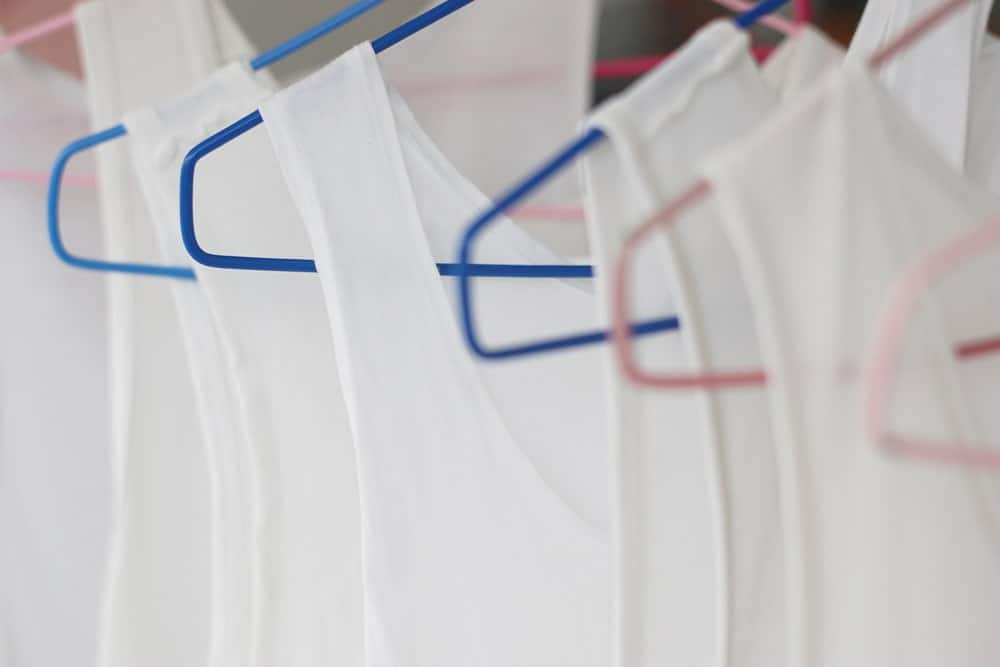
If you’ve never been especially keen on undershirts, you may be wondering if wearing one is really worth it. Here are some reasons to do it.
It Protects Your Clothing
An undershirt is primarily an upper-body sweat rag — the first line of defense to protect your outer layer of clothing from perspiration. Clothes can be costly, so why not protect your investment? Wearing an undershirt makes your regular shirts last longer. That means fewer online browsing sessions or trips to the store.
It Can Flatten Your Physique
Have love handles that get in the way when you’re wearing your workshirts? Undershirts with a slim fit can flatten out your physique, although that’s not the reason most guys put them on. Sometimes, those flaws can be a little more obvious when you’re wearing fabrics that are on the more see-through side. Having an undershirt under the outer one makes it less transparent and therefore makes your body contours less conspicuous.
It’s an Extra Layer of Insulation
Spend a lot of time outside in the winter? If you’d rather not wear long johns (and we totally get it if that’s the case), at least wearing some upper body underwear will help keep you warmer, longer.
Should You Wear an Undershirt Under a T-Shirt?
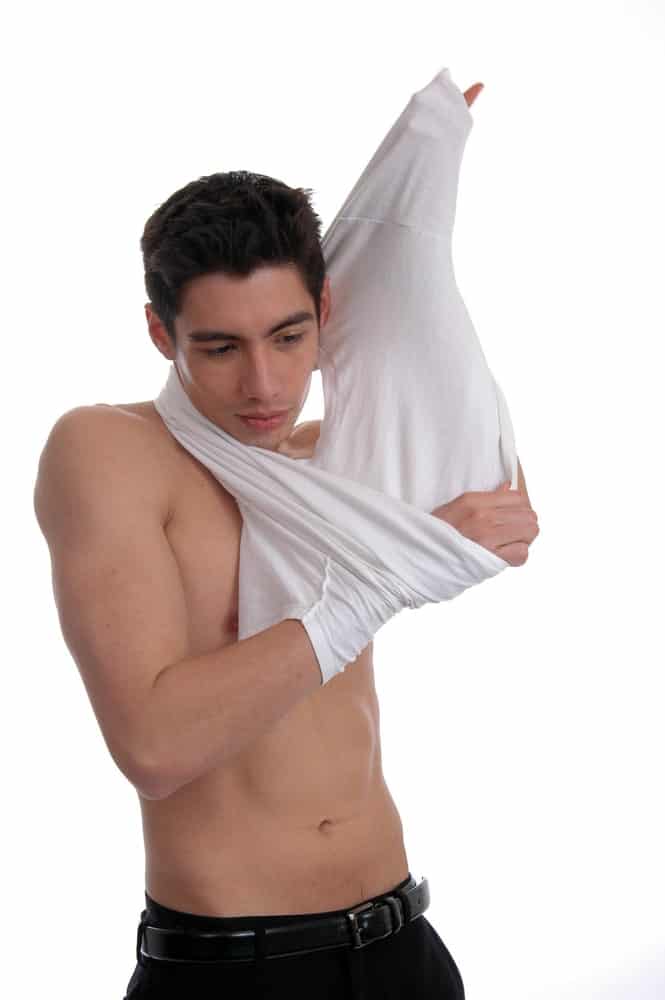
There is no “one-size-fits-all” answer to this question, so let’s unpack it in a little more detail.
For the most part, it’s about personal preference. Aside from that, there are a few points worth considering.
If you want to extend the lifespan of your favorite tees, go ahead. Guys accustomed to wearing an undershirt with a dress shirt might not think of wearing one with a casual shirt. We’ve already covered how wearing an undershirt will make your T-shirt last longer. An undershirt with a T-shirt will also:
Help You Look More Put Together
For the most part, you’ll look classier with your shirt tucked in. Outer T-shirts are terrible at staying put like this. They’ll ride up and expose your belly. Even if you have six-pack abs, sporting that look is not advised.
Undershirts are longer than tees, so they’ll stay tucked in. So even if your T-shirt gets untucked, the undershirt will keep you from looking tacky. To be even more discreet, match the color of your T-shirt to the color of your undershirt (like a white tee and white undershirt).
There’s another reason an undershirt looks better under a tee. Sometimes, the outlines of nipples and chest hair can be visible under a T-shirt. An undershirt adds extra fabric to conceal them.
Be a Buffer Against Rougher Fabrics
Have a tee that’s stiff or scratchy? The undershirt will serve as a barrier between it and your skin.
Play a Role in Regulating Your Body Temperature
A quality undershirt is designed to keep you cool when it’s warm and warm when it’s cool. It makes sense that wearing one in the winter would help you retain body heat. But it might seem counterintuitive to wear an undershirt in the summer.
After all, who wants to wear another layer of clothing when it’s already hot outside” But the undershirt will absorb sweat to help keep you cool, not to mention protect your tee from sweat stains. (More on that in a bit).
Take the Transparency Out of a T-Shirt
It’s not uncommon for white or light-colored shirts to be somewhat transparent. Add a little water or perspiration to the mix, and you can see right through them. Awkward. An undershirt stops the see-through effect in two ways. First, it adds a base layer of material between your skin and the T-shirt. Second, it absorbs the moisture that enhances the transparency in the first place.
So What’s the Difference Between an Undershirt and a T-shirt, Anyway?

Some confusion often surrounds the T-shirt vs. undershirt question, especially since some people refer to short-sleeved undershirts as T-shirts. However, these are not synonymous with each other. Here’s why.
For starters, these two garments are not sold in the same part of the store, but in two separate departments. Undershirts are in the men’s underwear section, while T-shirts are in the men’s outerwear department.
Another reason undershirts don’t qualify as T-shirts (and vice versa) is the consistency of the fabric they’re stitched together with. Since undershirts qualify as underwear and are meant to be nearly, or more often completely, invisible, they’re made of thinner material than your typical tee.
Because they’re supposed to work behind the scenes, undershirts don’t come in as many colors and styles as T-shirts. While these undergarments do come in several colors, the most common ones are neutral hues – gray, white, and tan. Most of the time, they’re one solid color with no other additions.
T-shirts, on the other hand, are meant to be on display. So they come in lots of colors and are often printed with all kinds of logos and lettering. They’re a means of self-expression. Undershirts do not (and should not) serve that purpose. And, of course, T-shirt material is usually thicker than undershirt fabric.
As we pointed out earlier, undershirts and tees serve different purposes. An undershirt is meant to be worn under a collared dress shirt. Their purpose is to diminish the transparency of the layered shirt and absorb sweat. T-shirts probably aren’t any more effective at wicking perspiration than your work shirt is. One way to think of it is: Undershirts keep you cool; T-shirts keep you looking cool.
And the neckline of the T-shirt would probably be difficult to hide under a dress shirt, unless you buttoned it all the way up, which could be really uncomfortable by day’s end.
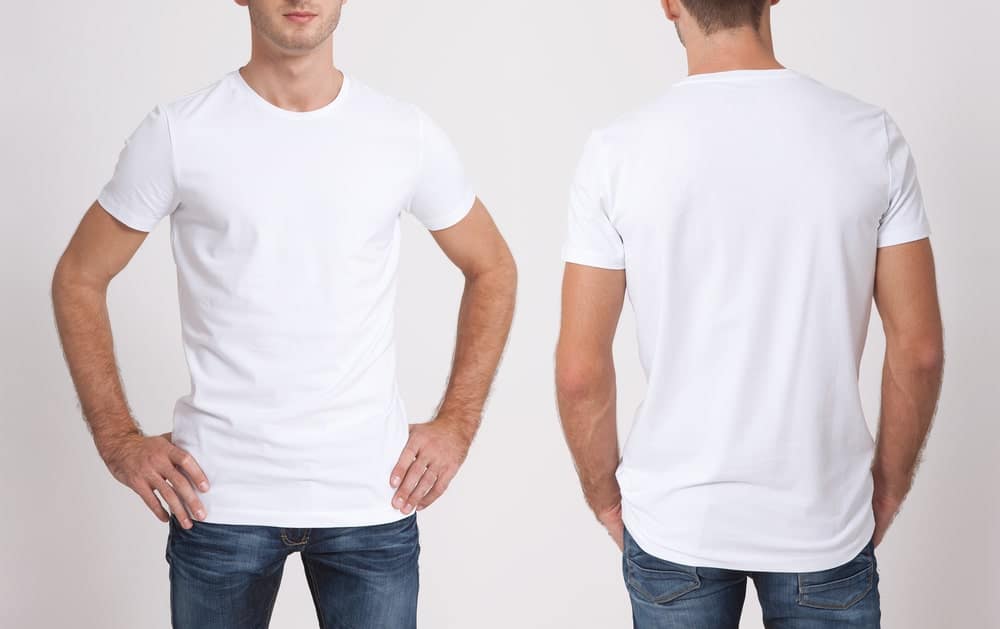
Undershirts are longer, as they are meant to be tucked in. T-shirts never stay in place because they’re shorter and usually have a loose fit. They’ll come untucked at the slightest movement.
And if they are long enough to tuck in, you end up sitting on them. This will feel unnatural most of the time because the shirts are thicker and not meant to be worn this way.
If an undershirt has sleeves at all, they’re shorter and more fitted than they are on a T-shirt. If they were not, they might be visible through a T-shirt, especially a light-colored one. In fact, undershirts, in general, are more form-fitting than most T-shirts. This keeps them from bunching up under your outerwear and calling unwanted attention to you.
While undershirts come in a variety of neckline depths, the V neck is the most common of these. The idea, of course, is that the undergarment should be completely hidden, including the collar. T-shirts come with a variety of necklines because they’re meant to be seen anyway. So the type of collar — crew, V neck — doesn’t really matter from a functionality standpoint.
How To Remove Deodorant Stains from an Undershirt

If you’ve ever sweated while wearing a white T-shirt or dress shirt, then you know the tell-tale trail of evidence that’s left behind: golden splotches in the armpit area. It’s not the perspiration itself that causes these “stains of shame,” it’s the result of the chemical reaction that occurs when the outpouring of your pores combines with the aluminum in your antiperspirant.
But don’t give up on wearing deodorant. You can follow some simple steps to remove the spots. So without further ado…we now present to you…Pit Stain Removal 101.
Do Not Use Bleach
Since it’s a whitening agent, bleach is often our go-to to restore a garment to its pristine white state. Applying a good bit of bleach to white fabrics can backfire on you, and treating sweat spots is no exception. In this case, the chlorine substance will only make those golden circles even worse. Just think of it as one of the “pitfalls” of using bleach.
Approach Dishwashing Soap and Ammonia with Caution
Guys don’t talk about perspiration stains, which leaves us to battle them in lonely isolation. This makes for a lot of trial and error when attempting to restore blighted clothing. But the problem is so prevalent that the University of Illinois actually has a department dedicated to it (well, actually to combating stains in general). It is called the Extension Stain Solutions Department. It recommends the following remedy for sweat spots:
- Use a dull butter knife to scrape any stain residue from the garment. (Definitely an outside-the-box use for a butter knife).
- Fill a container with a quart of lukewarm water, half a teaspoon of dish detergent, and one tablespoon of ammonia.
- Thoroughly soak the yellowed parts of the shirt in the solution for 10-15 minutes. While that’s going on, gently rub the stain from the back to loosen it.
- When you’re done scrubbing, soak the shirt for 15 minutes.
- Rinse and machine wash as usual.
For mild stains, this is probably all that’s needed. However, it may not get the job done for especially stubborn stains. If this solution works for you, great. If not, there are some other techniques you can try before retiring the shirt to the trash.
OxiClean Lives Up to Its Name
The label on a tub of OxiClean claims that the stuff can tackle just about anything. To use it on sweat splotches, just combine a warm water-filled sink with a scoop of the washing powder. Toss your much-maligned shirt in the sink, and make sure the stains are totally submerged.
For minor stains, one hour of soaking should be enough. For heavy or long-standing stains, an overnight bath may be needed. Afterward, rinse and machine wash as you normally would.
This remedy should do the trick. Some people like to rub a little OxiClean and water onto the stain before soaking. We’re not sure if this is necessary but it shouldn’t do any harm. Otherwise, just follow the directions on the container.
A quick note about OxiClean: It’s color-safe, so it can take care of perspiration stains on a non-white shirt as well. However, the powerful cleaner can make your clothes more prone to fading. Before you begin battling the stain, you may want to test out the OxiClean on a part of the shirt that won’t be readily visible to others.
Stain-Specific Remover Can Be a Good Match for Sweat
Another option you can try is to use a product called Raise that is made just for getting rid of sweat circles. All you have to do is place your shirt over a towel, spray the distressed pit areas with Raise, brush it in a bit, then let it sit for 15-20 minutes. Then, you can launder the shirt as you usually do.
How to Prevent Yellow Perspiration Stains
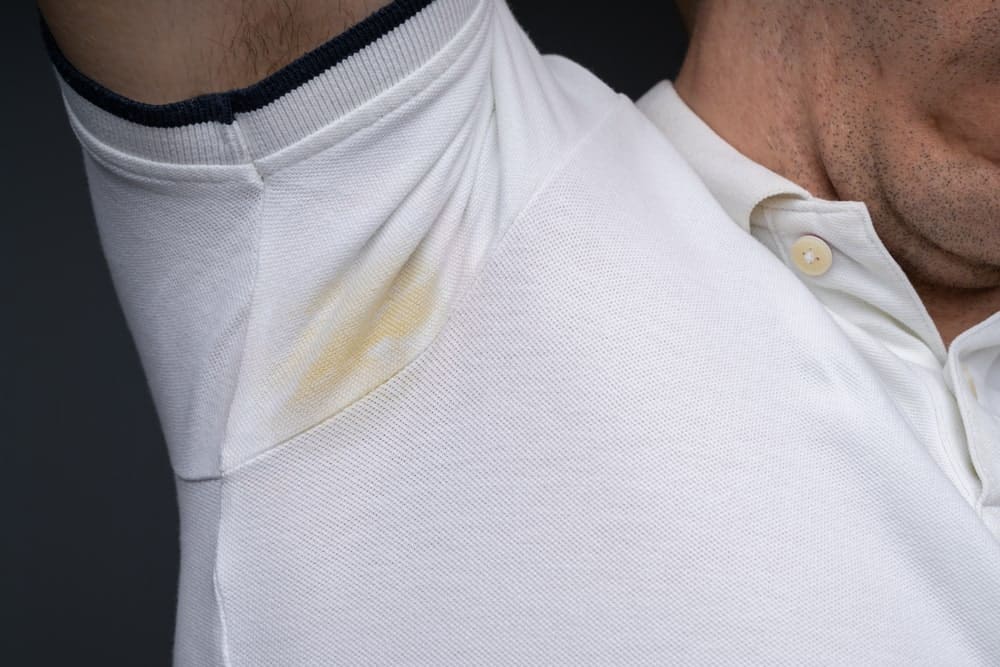
Treating stains can be a hassle, especially when you achieve subpar results. The good news is, you can take steps to prevent those sweat circles in the first place.
Wear an Undershirt
To protect your work clothes and other attire from sweaty pits, wear an undershirt. Stains can be tolerated in undershirts because no one’s going to see them anyway. And you can always treat them and still live with the results even if they’re not perfect.
Wash Shirts Right After Wearing
The longer you wait to wash your wet-with-sweat shirts, the more time those stains have to set. And when they do, they are virtually impossible to get rid of. To beat the clock, get those garments laundered as soon as possible after wearing them. For good measure, give the armpits a good dose of OxiClean or some other stain-fighting product before throwing the shirts in the wash.
Stay away from Aluminum Antiperspirants
Since the aluminum in antiperspirants mixing with your perspiration is what causes those stains, keeping these types of deodorant out of your hygiene regimen will prevent the spots. However, it can be difficult to find a non-aluminum substitute. You shouldn’t have to make a choice between putting up with armpit stains and going without deodorant. So following this tip should be a last resort.
Look for Antiperspirants That Prevent Stains
Admittedly, options for products like this are limited. But deodorant makers are well aware of the prevalence of pit stains and are constantly working to develop products that minimize them. For now, Speed Stick offers something that reduces pit impact while still keeping perspiration at bay.
Gold Bond Can Be Your Golden Ticket
Try using your regular deodorant with some Gold Bond Powder. The Gold Bond doesn’t contain aluminum and has antiperspirant properties. Plus, it feels great on your skin.
Trim Pit Growth
Part of what causes pit odor and increases sweat volume is an overabundance of armpit hair. Keeping it trimmed can cut down on how much you sweat and the intensity of stains. We are not suggesting you shave your pits. It’s just a matter of keeping the hair growth under control.
FAQs
What is undershirt pilling and what can be done about it?
If you’re doing online research about undershirts, or clothes in general, you may come across something called undershirt pilling. Like many of us, you may be unfamiliar with this term. When clothes have been around for a while, you may notice small fabric clumps forming on them, especially after washing.
These give your clothes a worn-out look. This effect is called pilling because the fibers form little “pills” all over the garment. Normal wear and tear can cause weaker fabric fibers to break and get tangled up around stronger ones, forming those little clumps.
Some materials are more susceptible to pilling than others. Cotton, wool, polyester, and other synthetics and synthetic blends are more likely to pill. On the other hand, the chance of pilling is a lot lower with natural fiber (linen, silk, merino wool). Here are some tips to prevent pilling so your undershirts and other clothes look better longer.
- Before washing, turn the garment inside out. This minimizes abrasion during laundering.
- Sort garments before washing. For clothes that are prone to pilling, launder them using your machine’s “gentle” or “hand washing” cycle. Avoid laundering lint-producing articles, like robes and towels, with other clothes. Likewise, don’t wash delicate and heavy-duty fabrics together.
- Minimize the use of bleach and other harsh detergents. Instead, opt for a detergent that contains cellulose. This ingredient breaks down fabric pills so they fall off.
- Use fabric softener in the rinse cycle. Fabric softener coats fibers to protect them from abrasion and pilling. If your machine has a fabric softener dispenser, you can pour the liquid in there and your machine will release it at the proper time.
- Reduce use of the dryer, at least for delicate fabrics. Hang these to dry if possible. Otherwise, remove them from the dryer as soon as possible to prevent strands of other fabrics from attaching to them.
- Don’t overload the machine. While we’ve probably all done this at some point, it leaves the clothes with less room to swirl around, making fabric fibers more likely to stick together.
How do you choose the right kind of undershirt?
Before you make a purchase, think about your budget and what you really want. If you’re wearing the undershirt to the gym or a labor-intensive job, then an athletic style may be the best way to go. if you just want something functional and economical and you don’t care how it looks, pick up a pack of good ol’ generic white cotton under tees. It’s important to choose something comfortable, too. If an undershirt is uncomfortable, it’s the wrong fit, the wrong material, or both).
Can you wear an undershirt under a polo shirt?
Let’s turn to GQ for some advice. According to those menswear gurus, trying to rock a polo and an undershirt is a bad idea. Polos are meant to be worn by themselves as casual attire. Wearing another layer under them will make you look bigger, and not in a way that’s flattering. Plus, if your polo sleeves are not long enough, you might be able to catch a glimpse of your tee sleeves sticking out.
Can you get away with wearing T-shirts and undershirts interchangeably?
No. Especially when you are wearing a dress shirt and don’t want what you are wearing underneath to show. Here’s the general rule of thumb: Undershirts are meant to be unseen, while T-shirts are meant to be seen, especially when you want to make a statement.
Can you wear an undershirt with a linen dress shirt?
If you’re wearing a linen dress shirt and aren’t sure if you need something under it, you have a few options. You can go without the undershirt, which may be permissible if you don’t sweat a lot. But it’s not the best course of action, as the linen is probably somewhat transparent.
A better choice is to wear an undershirt that is neutral in color (a hue that is similar to your skin color). Popular neutral selections include beige, tan, and leather gray.
Another possibility is to wear an undershirt in a color that contrasts with your linen dress shirt. One way to do this is to wear a color that’s the same hue as your pants. This achieves what some call a “stylistic” effect.
What are some things to keep in mind about dressy attire?
We’ve covered the most important points about buying undershirts. But what about the dress clothes over them? The best way to get the hang of it is to know what kinds of attire various occasions call for. Here are a few basic rules to keep in mind.
- White Tie. This is the epitome of formal. You will need to rent a tuxedo. Make sure the tux has tails, and the shirt has a bib front or pleats. Complete the tux with a white vest and white bow tie.
- Cocktail. Wear a suit and tie. You can don a spread collar in stripes, solid darks, or a crisp white if you want a more contemporary style.
- Semi-Formal. This is more formal than cocktail, but it doesn’t require a tux. If you’re not sure what to wear, showing up in a dark suit and crisp white dress shirt is the safest route.
- Black Tie. Arrive in style in a tux and a formal white or tuxedo dress shirt.
- Black Tie Optional. This is formal enough for a tux but casual enough that the tux is optional. If you’d rather not rent a tuxedo, stick with appropriately formal attire like a black suit paired with a crisp white dress shirt.
- Business Formal. Conservative styles of dress are in order here. Classic white, blue, or subtly patterned dress shirts are your best bet.
- Business Casual. This is the intersection of casual styles and sophisticated professionalism. Go with a checkered button-down or a colored Oxford shirt.



